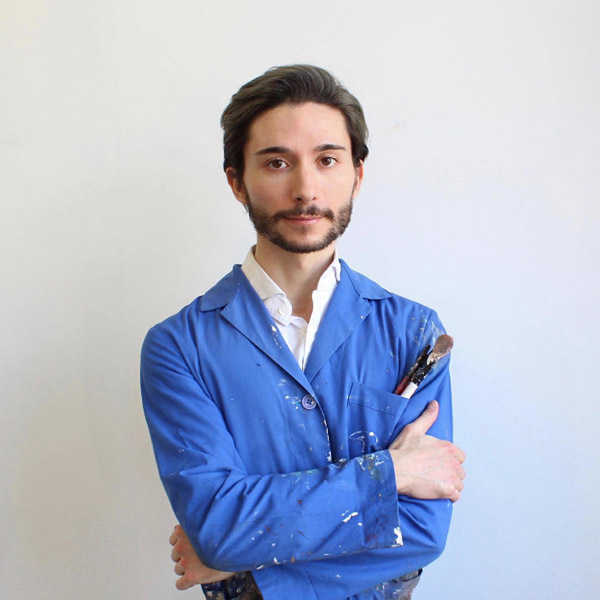Risquons-Tout, the last exhibition at WIELS, a contemporary art centre in the heart of Brussels, is a large collective show with thirty-nine international artists, in conjunction with the reopening of the post-lockdown art season in the Belgian capital. Hosted in the whole spaces of the museum, the project focusses on the work of artists of different generations: from Panamarenko to Sturtevant, to Ed Atkins and Laure Prouvost, as well as, among others, Kati Heck and Nora Turato. The selected artists question leitmotifs of any time and space, as well as hot topics of the contemporary status quo: postcolonialism, gender issues, critique of capitalism and surveillance, appropriation in art, institutional critique. All issues are inquired with different media, involving sight, hearing, as well as smell.
Despite that the common threads overarch global phenomena, the exhibition aims at focussing on a defined region in Europe, the so-called Eurocore: an international area, comprised between Paris, London, Amsterdam, and some German cities, like Dusseldorf and Cologne, were the selected artists work and live.
The exhibition’s title comes from Risquons-Tout, a hamlet on the Franco-Belgian border, which gained historically importance with an attempted and failed coup, in 1848, against the Belgian monarchy. The two combined words both evoke a real place and an imperative: a call to arms, an invocation to rescue, or an extreme reaction, due to a state of emergency.
Within the exhibition, the concept of risk meets two other capital threads in art history: the importance of chance in art making, and transgression. An artist such as Isaac Julien, with the video installation A Marvellous Entanglement (2019), reflects upon alternative ways of thinking about time, as well as urban landscape; utopias of urbanism; diasporas and identity; documentary storytelling, and fictionality. Referencing a statement by architect Lina Bo Bardi, a prominent name of Brazilian modernist architecture, Julien orchestrates a poetic dialogue between dancers and actors, against the background of some buildings by Bo Bardi, set between the metropolis and wilderness.
With a different take, the Franco-Algerian Neïl Beloufa reflects upon failed utopian messages, with a disenchanted polemic wit, as well as sardonic irony. L’ennemi de mon ennemi (2018) is an opulent installation, referencing events of the last decades, which took place on a global scale. The work, with a seemingly encyclopaedic aspiration, recalls installation design of history or war museums. Programmatically intricate, as well methodically organised, the work is a display of mobile tables, on which prints, ready-made, and sculptures are mixed altogether: effigies of world leaders lay over copies of artworks, and other disparate objects. Reflecting upon the turbulence of contemporary communication, Beloufa uses a theatrical ruse, originally theorised by Bertolt Brecht: the distancing effect. The spectator, after laughing at the misery of world leaders, in that misery seems to recognise, bewildered, her/his own fragility.
The works of other artists, counterpointing the work of Julien, seem to dissect as well the violence embedded in contemporary communication. Yet, these artists, mostly women, place the body at the centre of their inquiry, with daring nonchalance. Monika Stricker deconstructs, through painting, sculpture and video, a historical taboo in western art: the representation of male sex. What are the common features of a prosthesis, an archaeological find, and medico-legal photography? Reflecting upon the nature of such artefacts, juxtaposing different artworks within the installation space, Stricker writes an ode to absence. Either a face, a limb, or an organ, all missing parts could become present and tangible.
Similarly, yet through seemingly autobiographical statements, Evelyn Taochen Wang questions the representation of nakedness in art. She does so by using techniques from traditional Chinese painting. The artist seems to ask: in order to narrate one’s own supranational identity, which words, which images have to be chosen? The typically postmodern visual syncretism is here put into question, complexified by a personal interpretation of gender identity.
Other artists, such as Irene Kanga, approaches the question on how artistic research on the body and sexuality can have a biopolitical investment, beyond specific historical contingencies. Forced Love (2020), an installation of six sculptures made of chocolate, cast after a matrix made of clay, evokes the rape committed by a Belgian settler against a Congolese woman, in Congo, in 1931. The event, that led first to the killing of the settler, then to the subsequent massacre of several indigenous people, is both evoked within, and abstracted from, a specific historical context. In Kanga’s work, the obstention of the body eventually coincides with a fragile, edible monumentality.
An uncanny atmosphere dominates different rooms in the show, especially in the last spaces dedicated to the exhibition. Sensuality, endangered, seems to have fled from the bodies, and gone elsewhere.
Elio Ticca
Info:
Risquons-Tout
curated by Dirk Snauwaert, in collaboration with Zoe Gray, Devrim Bayar, Helena Kritis e Sofia Dati
12 September 2020 – 10 January 2021
WIELS
Avenue Van Volxemlaan 354, 1190, Bruxelles
 Nora Turato and Tarek Lakhrissi. Installation view, Risquons-Tout at WIELS, Brussels. Courtesy WIELS
Nora Turato and Tarek Lakhrissi. Installation view, Risquons-Tout at WIELS, Brussels. Courtesy WIELS
 Neïl Beloufa, L’Ennemi de mon ennemi, 2018. Installation view, Risquons-Tout at WIELS, Brussels. Courtesy WIELS
Neïl Beloufa, L’Ennemi de mon ennemi, 2018. Installation view, Risquons-Tout at WIELS, Brussels. Courtesy WIELS
 Irene Kanga, Forced Love, 2019. Installation view at Risquons-Tout at WIELS, Brussels. Courtesy WIELS
Irene Kanga, Forced Love, 2019. Installation view at Risquons-Tout at WIELS, Brussels. Courtesy WIELS
 Evelyn Taocheng Wang, False poster, 2020. Risquons-Tout at WIELS, Brussels. Courtesy WIELS
Evelyn Taocheng Wang, False poster, 2020. Risquons-Tout at WIELS, Brussels. Courtesy WIELS

Elio Ticca (Nuoro, Italy, 1988) is a visual artist and author. Graduated in visual arts and history of art, is a freelance contributor of Juliet Art Magazine, and other publications. He lives and works in Brussels.






NO COMMENT